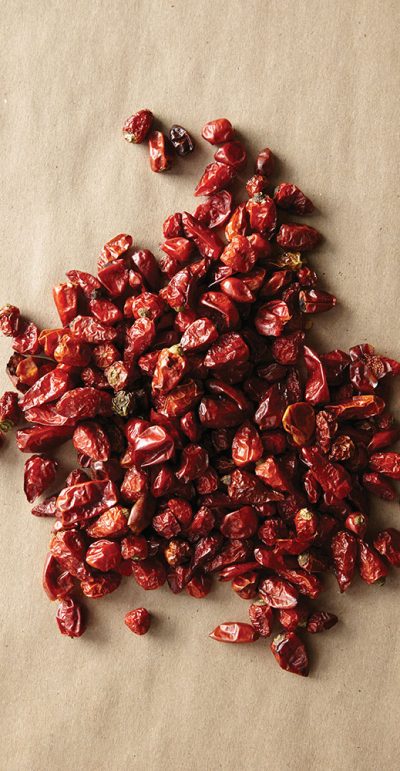
Let’s start by thanking birds for the riot of bottled hot sauces, chili cook-offs and fiery salsas we happily subject ourselves to today.
When the first wild peppers appeared in central Bolivia between 15,000 and 20,000 years ago, these tomato cousins had a botanically unique defense mechanism—stinging capsaicin—that successfully warded off the sensitive mouths of animals. Peppers were surviving, but they were literally going nowhere.
Birds, however, have relatively few taste buds and far simpler digestive tracts than animals. As James Beard Award-winning chef/scholar Maricel Presilla writes in her seventh book, Peppers of the Americas: The Remarkable Capsicums That Forever Changed Flavor, birds happily gobbled up the colorful fruits, “excreting the seeds whole and still viable” as they flew great distances. Thus did peppers begin their pan-American journey.
Presilla lays out this tale in her deeply researched, beautifully photographed and recipe-enriched book. More than 8,000 years ago, evidence from one Peruvian site shows, hunter-gatherers were cooking with peppers.
“In my mind,” she writes, “I see generations of women wielding their remarkably efficient crushing or grinding tools to extract maximum pepper flavor for a sauce or to bring bland staple foods to life with pepper heat.” Those staples included squash, maize, sweet potatoes and yuca.
Humans eventually domesticated five species of peppers, beginning in Mexico with Capsicum annuum, well before the Spanish got there.
Even if you haven’t heard of C. annuum, you’ve probably eaten some, because its cultivars include poblanos, serranos, jalapeños, chipotles (“which are really smoked jalapeños”), bell peppers, Italian frying peppers, piquillos and more. After Columbus brought examples of C. annuum to Ferdinand and Isabella in 1493, the merchants of colonial Spain and Portugal took it everywhere.
“For sheer visibility on every continent of the eastern and western hemisphere,” Presilla writes, “[it] eclipses all others.”
Her own deep dive into the subject began with a literal thunderclap. In 2002, a huge, wisteria-entwined Norway spruce that had long shaded her Weehawken backyard toppled in a storm. Suddenly, the narrow yard was flooded with light. She began planting herbs, but soon switched to peppers.
Having recently published her fourth book, The New Taste of Chocolate: A Cultural and Natural History of Cacao With Recipes, she wasn’t intending to start another. “It just escalated,” she says. “My typical Presilla method. I fall in love with stuff.”
A native Cuban, Presilla won her first James Beard Award in 2012 as chef of Cucharamama, her South American restaurant in Hoboken. She won her second a year later for her fifth book, Gran Cocina Latina: The Food of Latin America. Traveling across those lands for that 900-page opus fired her fascination with peppers to what she calls “obsessive” levels.
By the time the Obama White House called her in 2009 to cook for the first Fiesta Latina, she was so deeply into peppers that, when they asked her about flower arrangements, she insisted on filling glass cylinders with fresh peppers instead.
“It was the first time Latin American peppers arrived at the White House,” she says, “and I’m so glad it was me who did it.” She even used a few peppers from the First Lady’s garden. Dessert included her version of a 1644 Mexican hot chocolate.
Meanwhile, peppers were taking over not just her garden, but her house. She moved her macaws and Amazonian parrot into the dining room to devote the room they had occupied to growing peppers from seeds she had gathered in her travels or that her family in Cuba sent her.
In late spring, she moves seedlings into the garden, covering them with cages to protect them from squirrels. Her two dogs can be scamps. One likes to nibble on leaves, and both like to play with the pods, so she places the pots on trestles. One dug under a support, collapsing the trestle. “Comes a point, they get bored with it,” she says, “so by midseason it’s fine.”
Eventually, Presilla realized she was gestating a book. “Peppers, like cacao, are Latin-American staple plants,” she explains. “These are our treasures we are giving the world, so it made sense to do.”
Tending her garden, she is both the cucharamama (“mother spoon”) and the scholar who earned her PhD. in medieval history. “I talk to my peppers, and they tell me if they need fertilizer or water,” she says. “I check them two or three times a day and take copious notes on every detail of their growth. I bought a microscope. You can tell the species by looking at the shape of the seeds.
“I grow eggplants and tomatoes, but I absolutely love peppers,” she says. “To go into the garden and pick peppers for cooking is so pleasurable.” Given her gifts as a chef, the eating is probably even better.
Learn more at the book’s companion website, peppersoftheamericas.com.
